A Simplified 4-DOF Dynamic Model of a Series-Parallel Hybrid Electric Vehicle
Abstract
:1. Introduction
1.1. Motivations and Technical Challenges
1.2. Literature Review
1.3. Original Contributions
1.4. Outline of Paper
2. Description of the Powertrain and the Longitudinal Dynamic Model
3. Establishment of 16-DOF Full-Order Model
4. The 4-DOF Dynamic Model of the HEV Powertrain
5. Conclusions
Author Contributions
Funding
Data Availability Statement
Conflicts of Interest
References
- Castellano, A.; Stano, P.; Montanaro, U.; Cammalleri, M.; Sorniotti, A. Model predictive control for multimode power-split hybrid electric vehicles: Parametric internal model with integrated mode switch and variable meshing losses. Mech. Mach. Theory 2024, 192, 105543. [Google Scholar] [CrossRef]
- Beatrice, C.; Capasso, C.; Doulgeris, S.; Samaras, Z.; Veneri, O. Hybrid storage system management for hybrid electric vehicles under real operating conditions. Appl. Energy 2024, 354, 122170. [Google Scholar] [CrossRef]
- Squalli, J. Environmental hypocrisy? Electric and hybrid vehicle adoption and pro-environmental attitudes in the United States. Energy 2024, 293, 130670. [Google Scholar] [CrossRef]
- Andrenacci, N.; Giuli, G.; Genovese, A.; Pede, G. Flexible Charging to Energy Saving—Strategies Assessment with Big Data Analysis for PHEVs Private Cars. World Electr. Veh. J. 2024, 15, 197. [Google Scholar] [CrossRef]
- Jian, B.; Wang, H. Hardware-in-the-loop real-time validation of fuel cell electric vehicle power system based on multi-stack fuel cell construction. J. Clean. Prod. 2022, 331, 129807. [Google Scholar] [CrossRef]
- Shao, Y.; Zulkefli, M.A.M.; Sun, Z.; Huang, P. Evaluating connected and autonomous vehicles using a hardware-in-the-loop testbed and a living lab. Transp. Res. Part C Emerg. Technol. 2019, 102, 121–135. [Google Scholar] [CrossRef]
- Walker, P.; Zhu, B.; Zhang, N. Powertrain dynamics and control of a two speed dual clutch transmission for electric vehicles. Mech. Syst. Signal Process. 2017, 85, 1–15. [Google Scholar] [CrossRef]
- Walker, P.; Zhang, N. Active damping of transient vibration in dual clutch transmission equipped powertrains: A comparison of conventional and hybrid electric vehicles. Mech. Mach. Theory 2014, 77, 1–12. [Google Scholar] [CrossRef]
- Walker, P.; Zhang, N.; Tamba, R. Control of gear shifts in dual clutch transmission powertrains. Mech. Syst. Signal Process. 2011, 25, 1923–1936. [Google Scholar] [CrossRef]
- Shin, S.; Choi, S.B. Control-oriented modeling of wet clutch friction considering thermal dynamics. Mechatronics 2024, 99, 103146. [Google Scholar] [CrossRef]
- Wang, Y.; Wu, J.; Zhang, N.; Mo, W. Dynamics modeling and shift control of a novel spring-based synchronizer for electric vehicles. Mech. Mach. Theory 2022, 168, 104586. [Google Scholar] [CrossRef]
- Zhang, Z.; Yang, B.; Zhang, Y.; Li, L.; Zhao, B.; Zhang, T. Powertrain modeling and performance simulation of a novel flywheel hybrid electric vehicle. Energy Rep. 2023, 9, 4401–4412. [Google Scholar] [CrossRef]
- Ouyang, T.; Huang, G.; Li, S.; Chen, J.; Chen, N. Dynamic modelling and optimal design of a clutch actuator for heavy-duty automatic transmission considering flow force. Mech. Mach. Theory 2020, 145, 103716. [Google Scholar] [CrossRef]
- Mo, S.; Chen, K.; Zhang, Y.; Zhang, W. Vertical dynamics analysis and multi-objective optimization of electric vehicle considering the integrated powertrain system. Appl. Math. Model. 2024, 131, 33–48. [Google Scholar] [CrossRef]
- Park, G.; Lee, S.; Jin, S.; Kwak, S. Integrated modeling and analysis of dynamics for electric vehicle powertrains. Expert Syst. Appl. 2014, 41, 2595–2607. [Google Scholar] [CrossRef]
- Yakhshilikova, G.; Ruzimov, S.; Tonoli, A.; Mukhitdinov, A. Impact of Engine Inertia on P2 Mild HEV Fuel Consumption. World Electr. Veh. J. 2024, 15, 220. [Google Scholar] [CrossRef]
- Walker, P.; Zhang, N. Modelling of dual clutch transmission equipped powertrains for shift transient simulations. Mech. Mach. Theory 2013, 60, 47–59. [Google Scholar] [CrossRef]
- Zhang, J.; Tang, X.; Yu, H.; Zou, L. Multi-body dynamics and noise analysis for the torsional vibration of a power-split hybrid driveline. Proc. Inst. Mech. Eng. Part K J. Multi-Body Dyn. 2014, 228, 366–379. [Google Scholar] [CrossRef]
- Tang, X.; Yang, W.; Hu, X.; Zhang, D. A novel simplified model for torsional vibration analysis of a series-parallel hybrid electric vehicle. Mech. Syst. Signal Process. 2017, 85, 329–338. [Google Scholar] [CrossRef]
- Morandin, M.; Bolognani, S.; Faggion, A. Active torque damping for an ice-based domestic chp system with an spm machine drive. IEEE Trans. Ind. Appl. 2015, 51, 3137–3146. [Google Scholar] [CrossRef]
- Albers, A.; Albrecht, M.; Krüger, A.; Lux, F. New Methodology for Power Train Development in the Automotive Engineering-Integration of Simulation, Design and Testing. SAE Tech. Pap. 2001, 01, 3303. [Google Scholar]
- Kahraman, A. Free torsional vibration characteristics of compound planetary gear sets. Mech. Mach. Theory 2001, 36, 953–971. [Google Scholar] [CrossRef]
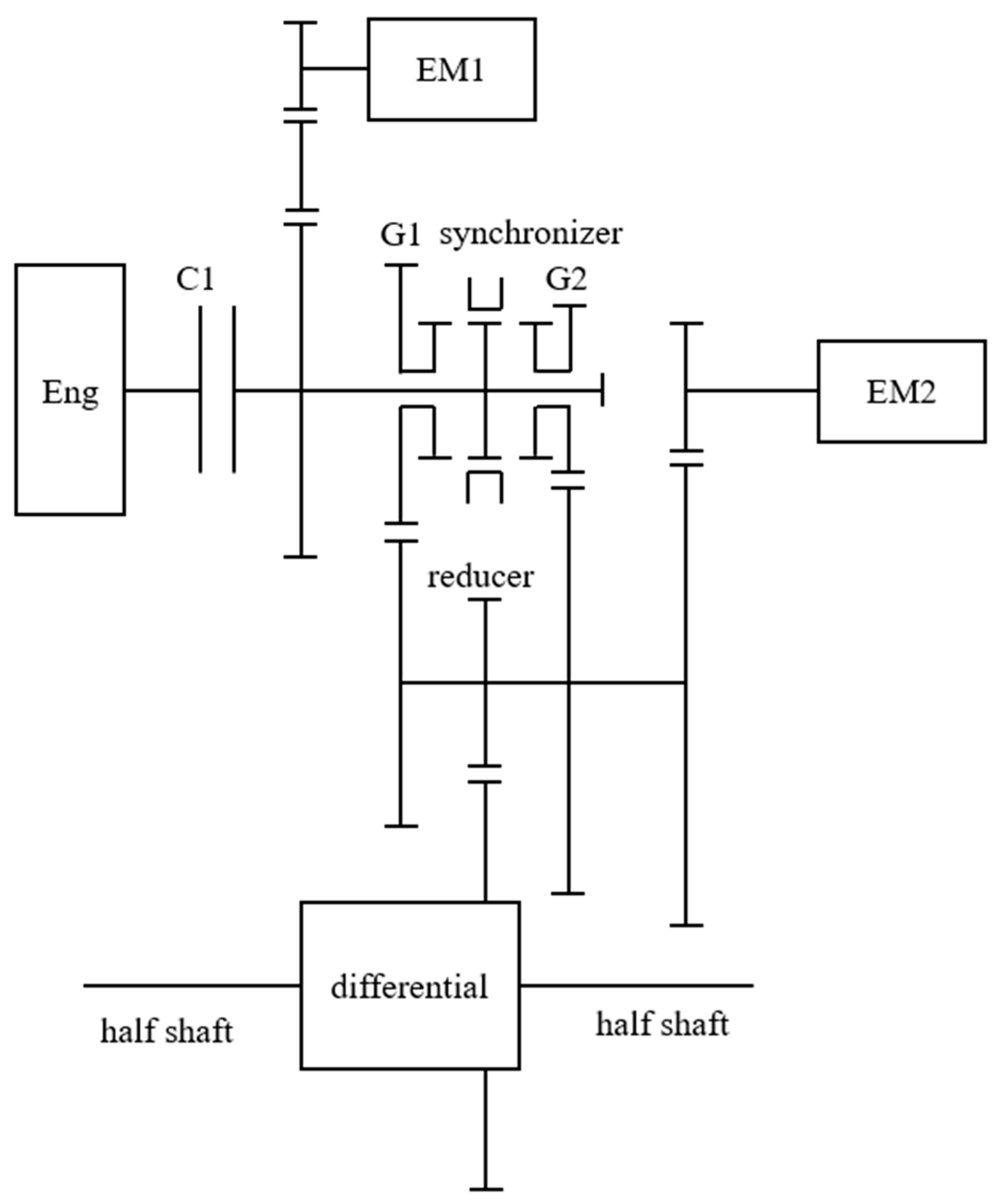
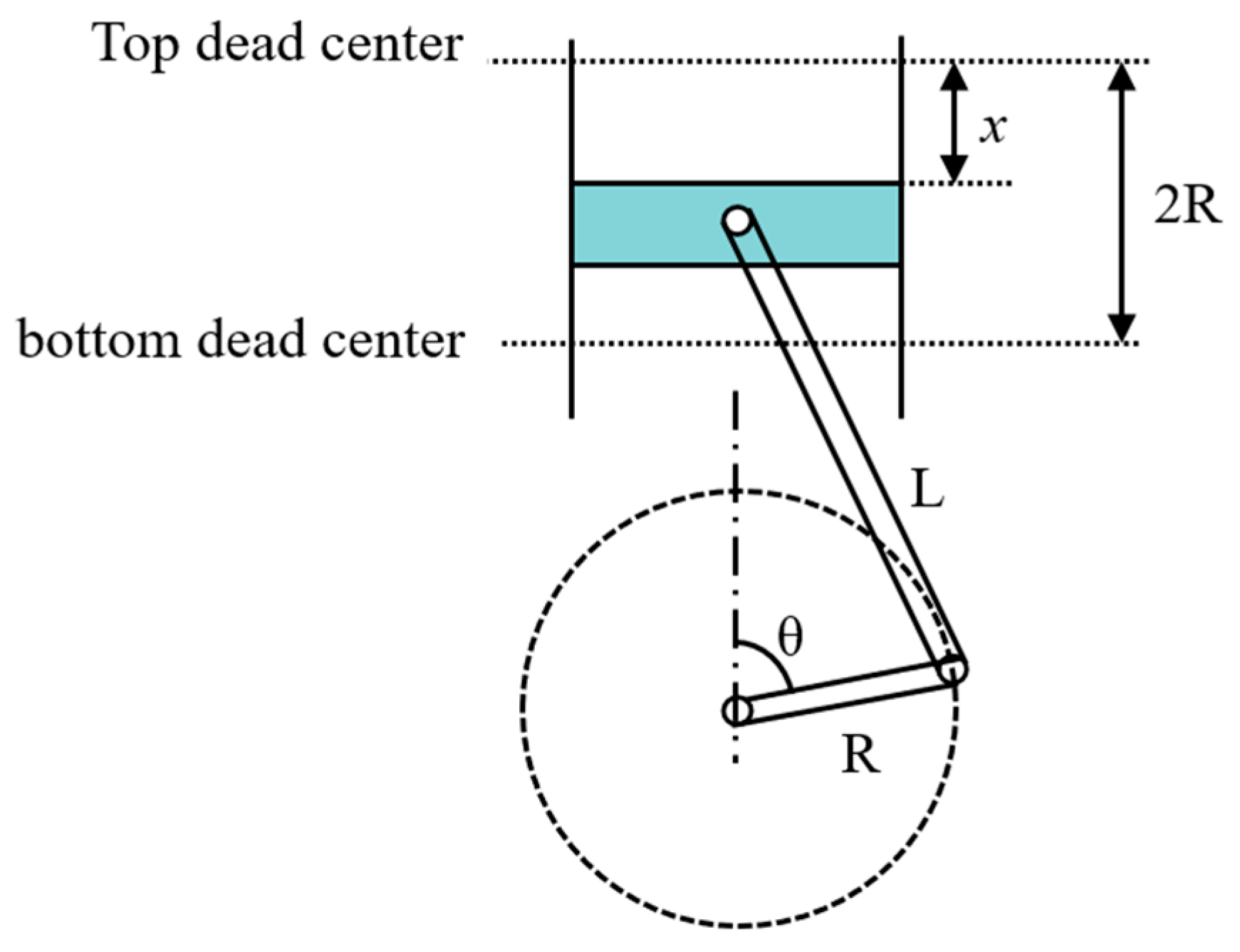
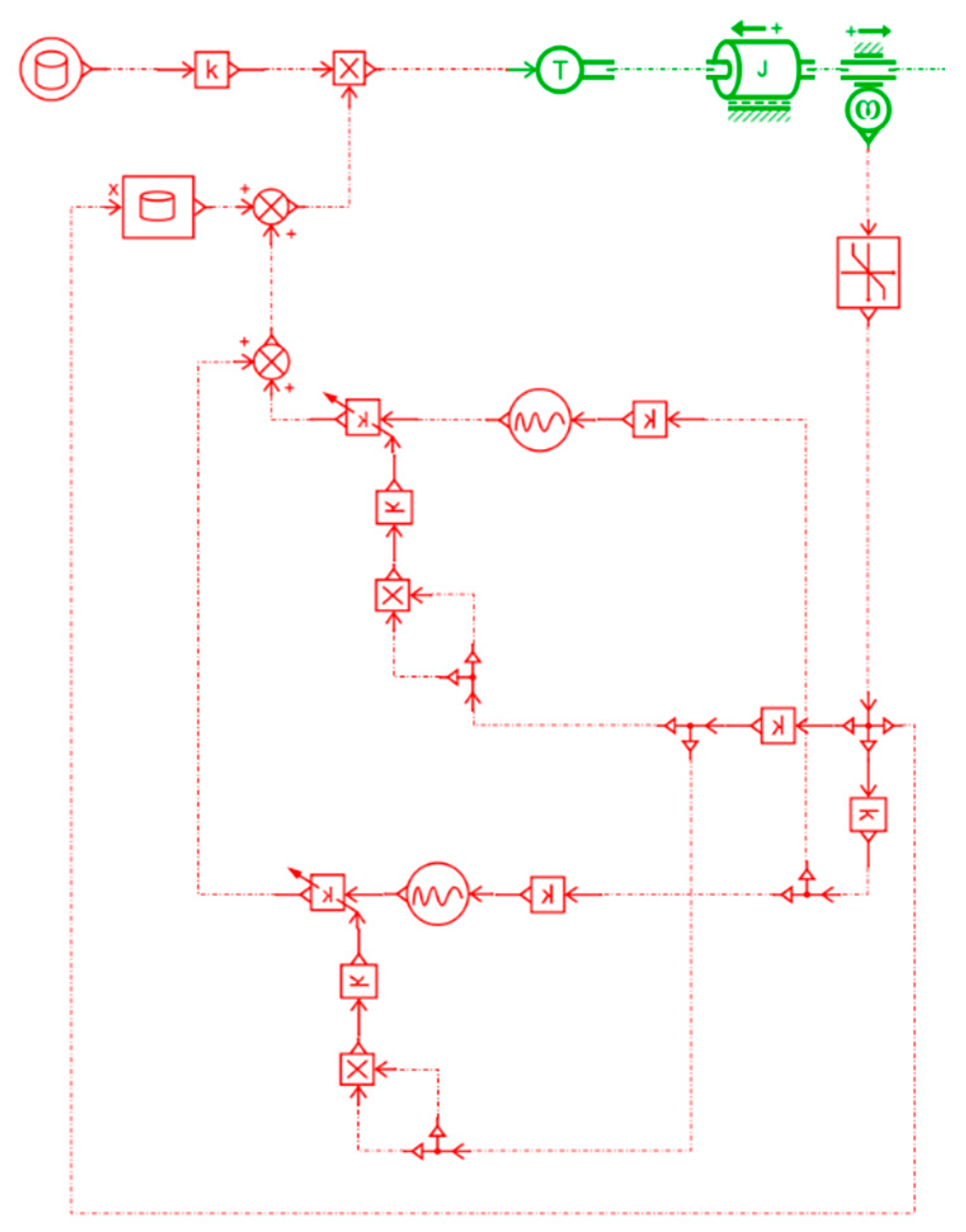

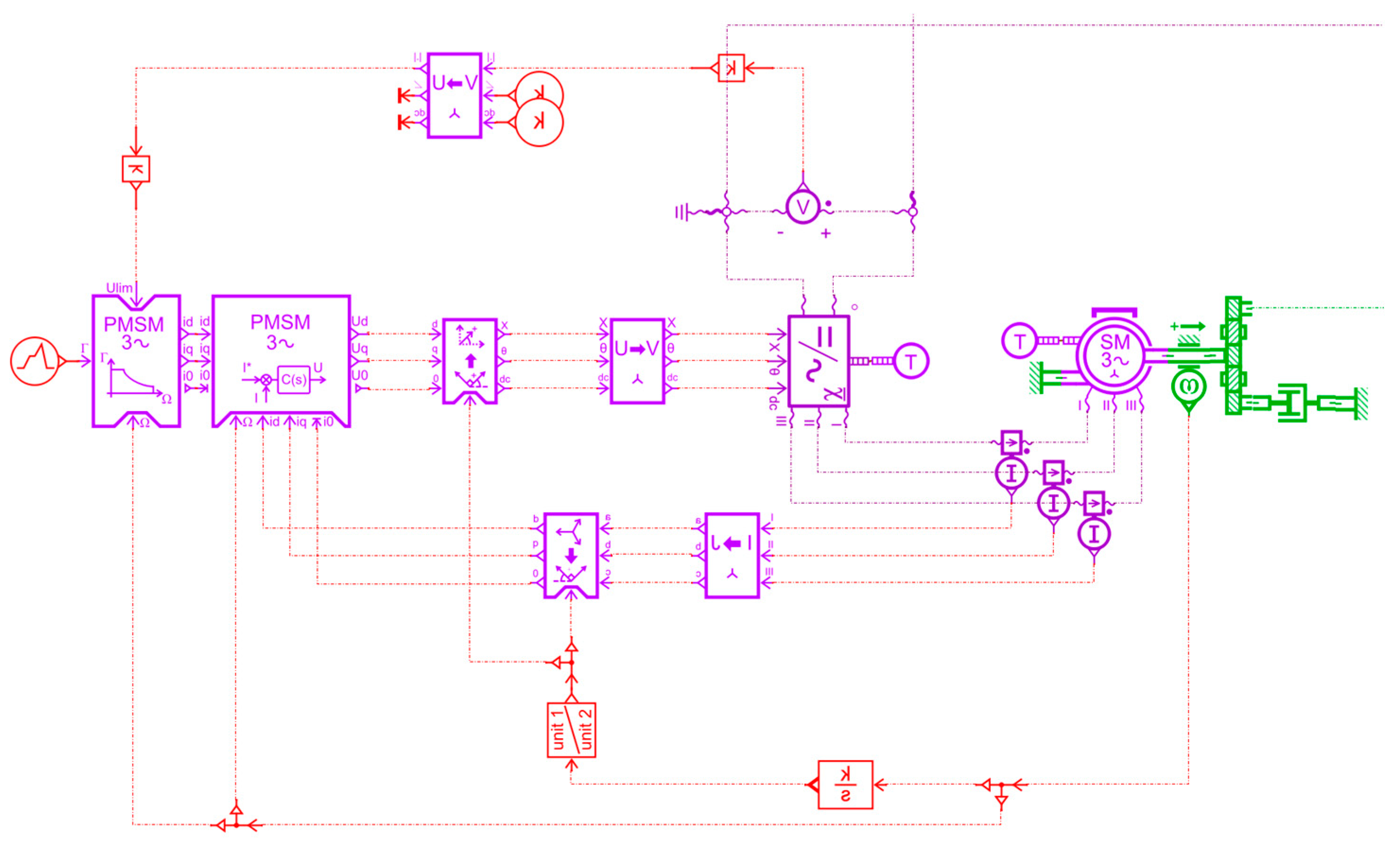
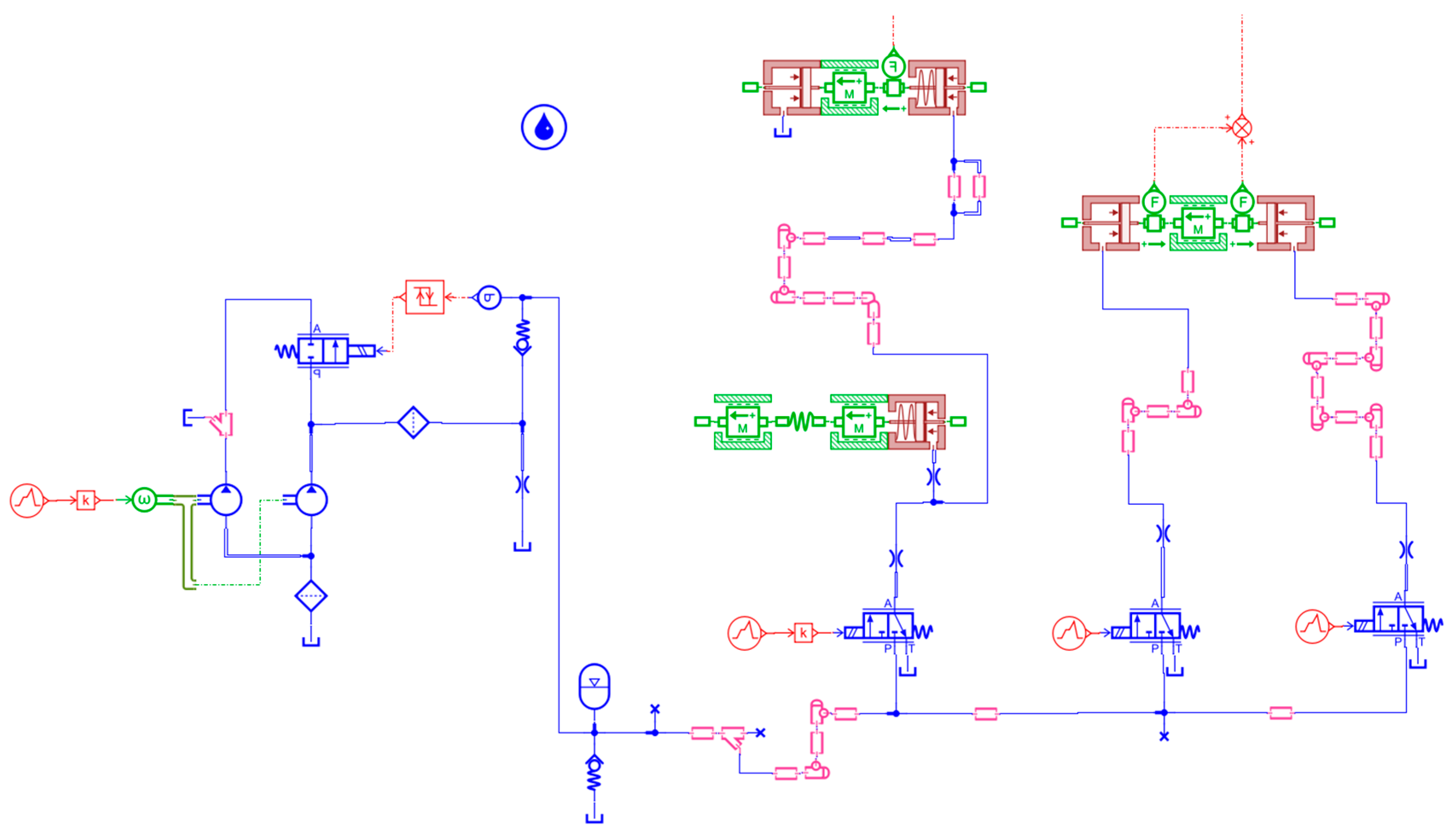
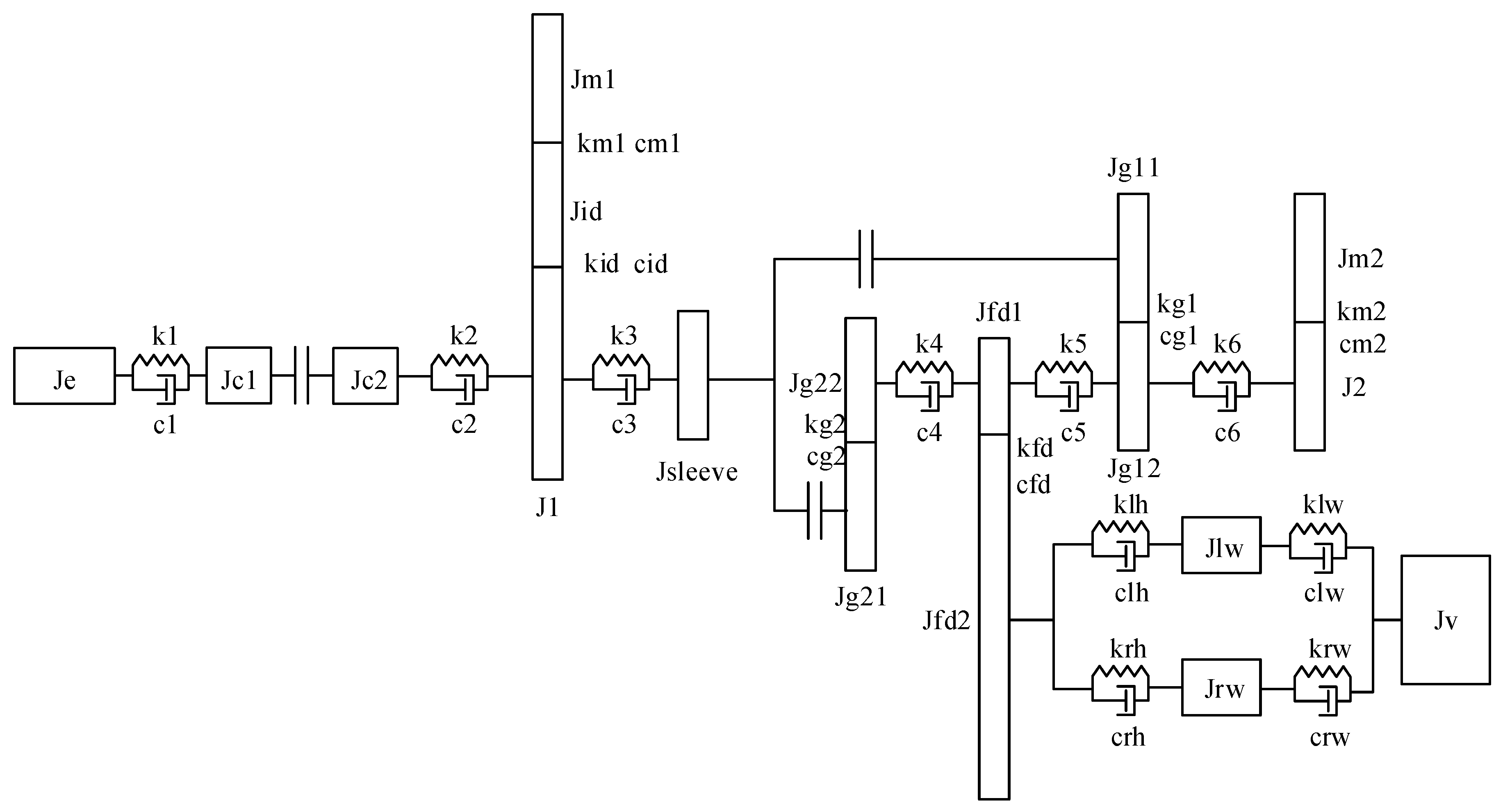
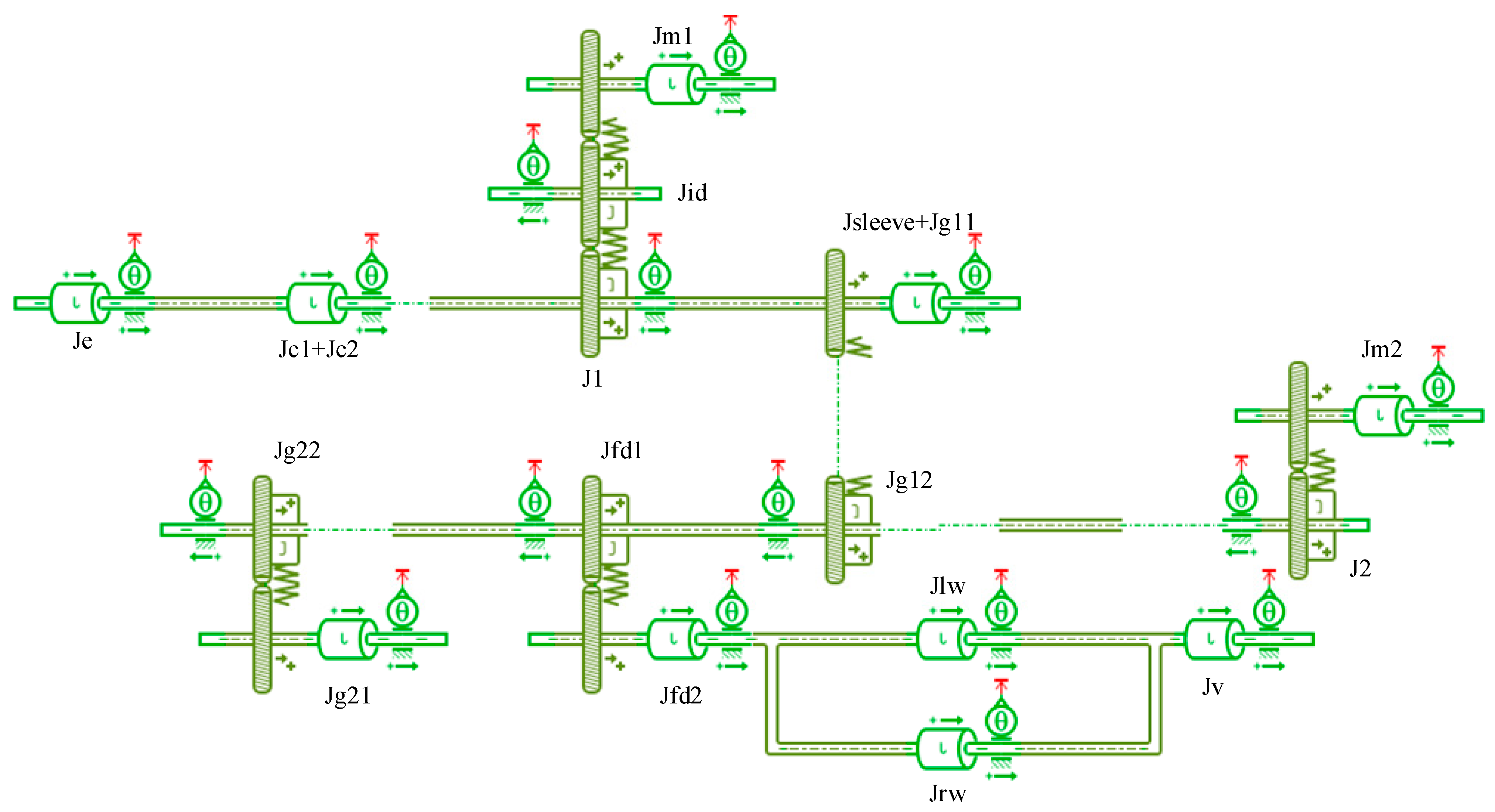
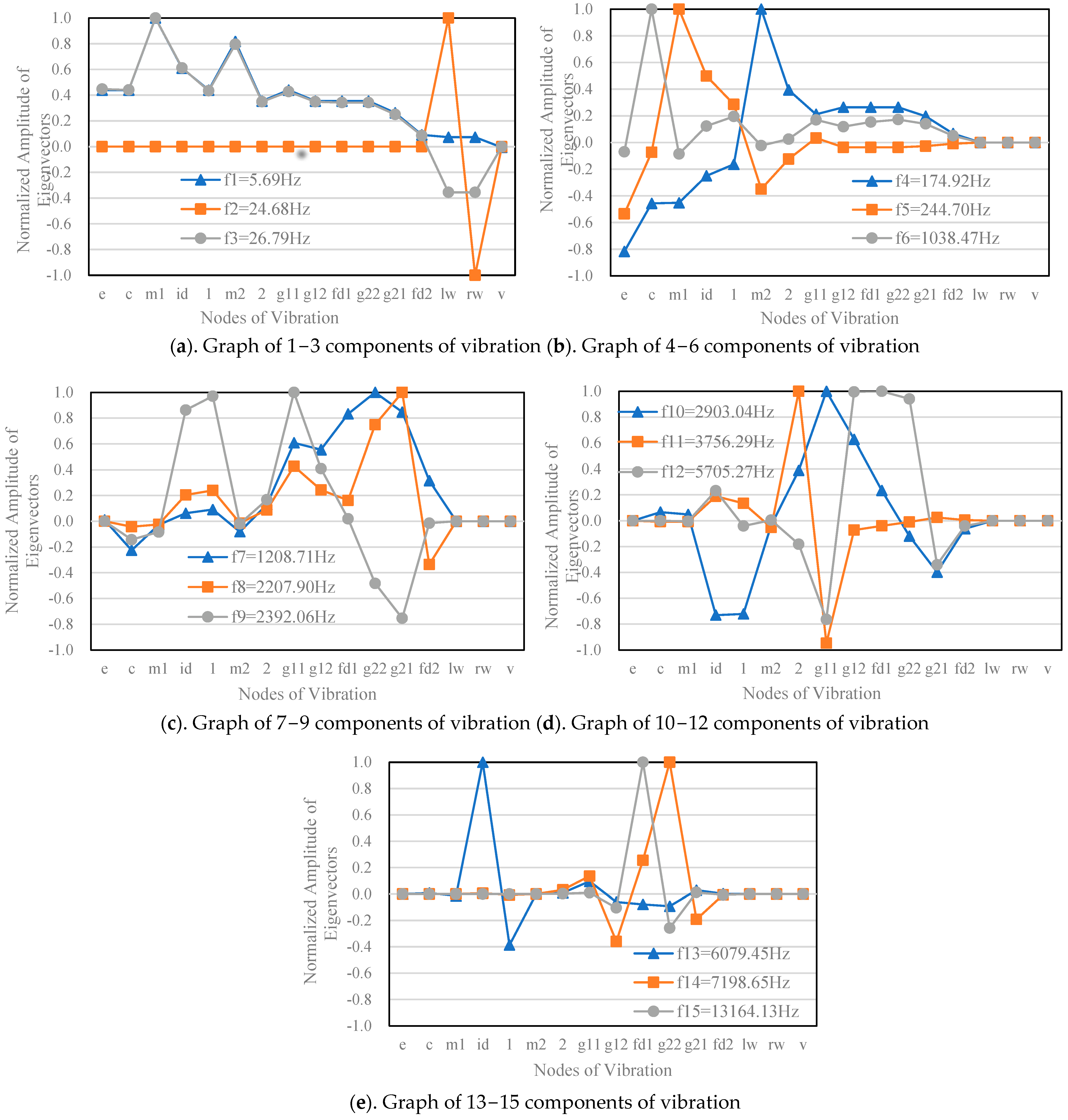
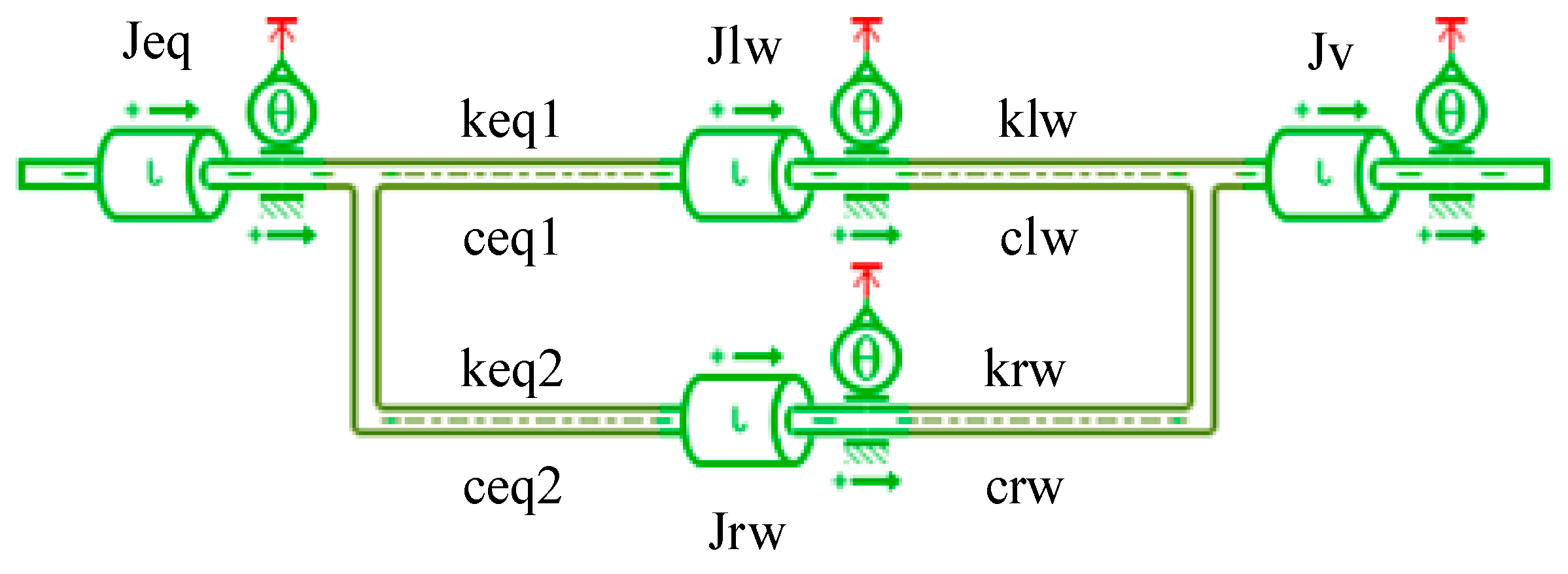
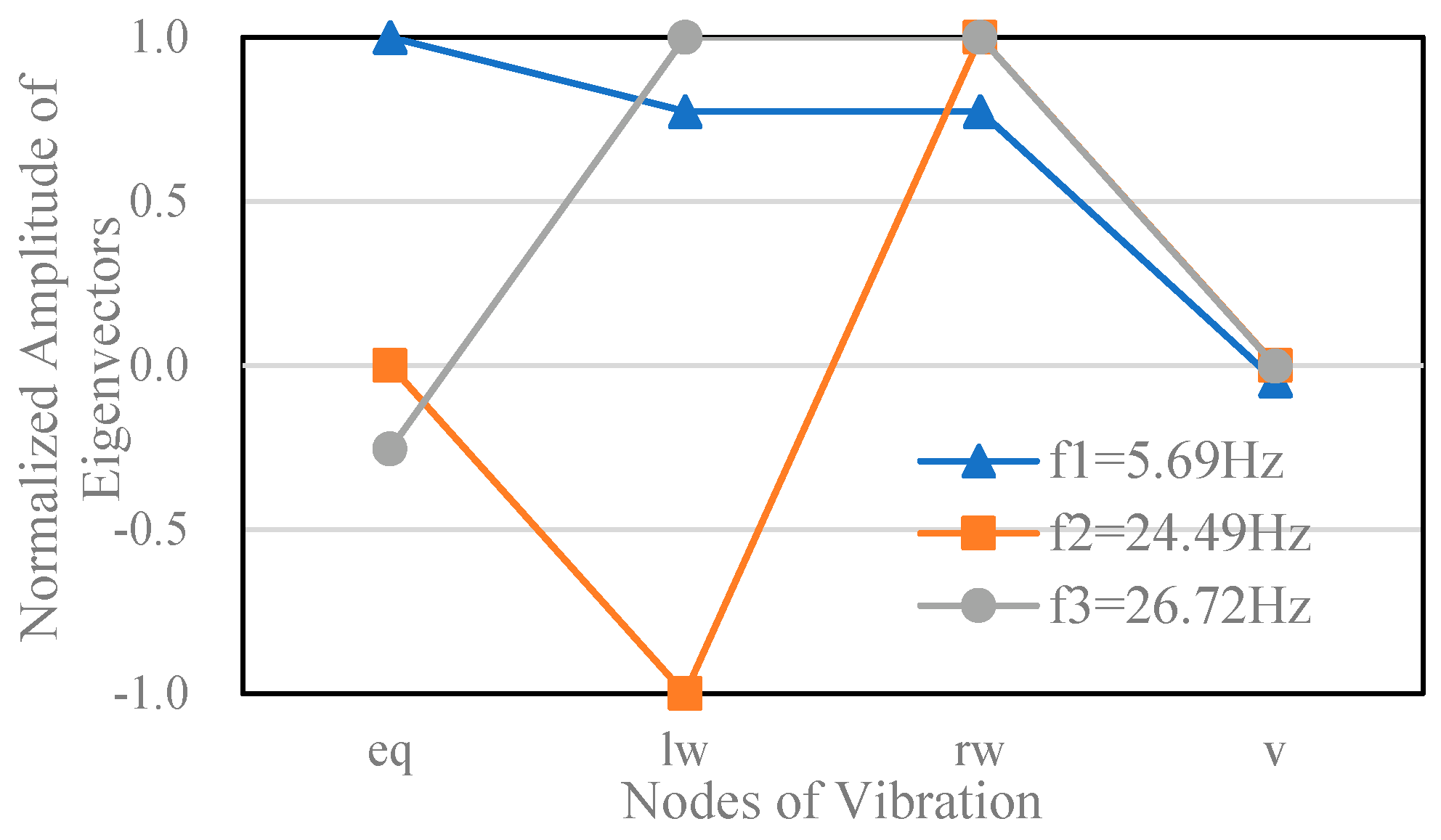

| Parameter | Description | Parameter | Description | Parameter | Description |
|---|---|---|---|---|---|
| Je | Engine | k1 | stiffness of shaft 1 | c1 | damping of shaft 1 |
| Jc1 | Clutch inner hub | k2 | stiffness of shaft 2 | c2 | damping of shaft 2 |
| Jc2 | Clutch outer hub | k3 | stiffness of shaft 3 | c3 | damping of shaft 3 |
| Jm1 | EM1 and drive gear | k4 | stiffness of shaft 4 | c4 | damping of shaft 4 |
| Jid | Idle gear | k5 | stiffness of shaft 5 | c5 | damping of shaft 5 |
| J1 | Driven gear of EM1 | k6 | stiffness of shaft 6 | c6 | damping of shaft 6 |
| Jsleeve | Synchronizer | km1 | mesh stiffness | cm1 | mesh damping |
| Jg11 | Gear 11 | kid | mesh stiffness | cid | mesh damping |
| Jg12 | Gear 12 | kg1 | mesh stiffness | cg1 | mesh damping |
| Jg21 | Gear 21 | kg2 | mesh stiffness | cg2 | mesh damping |
| Jg22 | Gear 22 | kfd | mesh stiffness | cfd | mesh damping |
| Jfd1 | Drive gear of reducer | km2 | mesh stiffness | cm2 | mesh damping |
| Jfd2 | Driven gear of reducer | klh | stiffness of half shaft | clh | damping of half shaft |
| Jm2 | EM2 and drive gear | krh | stiffness of half shaft | crh | damping of half shaft |
| J2 | Driven gear of EM2 | klw | stiffness of left wheel | clw | damping of left wheel |
| Jlw | Left wheel | krw | stiffness of right wheel | crw | damping of right wheel |
| Jrw | Right wheel | - | - | - | - |
| Jv | Vehicle body | - | - | - | - |
| Frequency | MATLAB (Hz) Damped | AMESim (Hz) Damped | MATLAB (Hz) Undamped | AMESim (Hz) Undamped |
|---|---|---|---|---|
| 1st | 5.70 | 5.70 | 5.69 | 5.69 |
| 2nd | 24.68 | 24.68 | 24.68 | 24.68 |
| 3rd | 26.78 | 26.78 | 26.79 | 26.79 |
| 4th | 174.92 | 174.92 | 174.92 | 174.92 |
| 5th | 244.70 | 244.70 | 244.70 | 244.70 |
| 6th | 1038.88 | 1038.88 | 1038.47 | 1038.47 |
| 7th | 1208.74 | 1208.74 | 1208.71 | 1208.71 |
| 8th | 2208.00 | 2208.00 | 2207.90 | 2207.90 |
| 9th | 2391.87 | 2391.87 | 2392.06 | 2392.06 |
| 10th | 2905.39 | 2905.39 | 2903.04 | 2903.04 |
| 11th | 3753.86 | 3753.86 | 3756.29 | 3756.29 |
| 12th | 5707.45 | 5707.45 | 5705.27 | 5705.27 |
| 13th | 6077.21 | 6077.21 | 6079.45 | 6079.45 |
| 14th | 7194.69 | 7194.69 | 7198.65 | 7198.65 |
| 15th | 13,163.53 | 13,163.53 | 13,164.13 | 13,164.13 |
| Frequency | 16-DOF, Damped (Hz) | 4-DOF, Damped (Hz) | 16-DOF, Undamped (Hz) | 4-DOF, Undamped (Hz) |
|---|---|---|---|---|
| 1st | 5.70 | 5.69 | 5.69 | 5.69 |
| 2nd | 24.68 | 24.49 | 24.68 | 24.49 |
| 3rd | 26.78 | 26.71 | 26.79 | 26.72 |
Disclaimer/Publisher’s Note: The statements, opinions and data contained in all publications are solely those of the individual author(s) and contributor(s) and not of MDPI and/or the editor(s). MDPI and/or the editor(s) disclaim responsibility for any injury to people or property resulting from any ideas, methods, instructions or products referred to in the content. |
© 2024 by the authors. Licensee MDPI, Basel, Switzerland. This article is an open access article distributed under the terms and conditions of the Creative Commons Attribution (CC BY) license (https://creativecommons.org/licenses/by/4.0/).
Share and Cite
Dai, L.; Hu, P.; Wang, T.; Bian, G.; Liu, H. A Simplified 4-DOF Dynamic Model of a Series-Parallel Hybrid Electric Vehicle. World Electr. Veh. J. 2024, 15, 390. https://doi.org/10.3390/wevj15090390
Dai L, Hu P, Wang T, Bian G, Liu H. A Simplified 4-DOF Dynamic Model of a Series-Parallel Hybrid Electric Vehicle. World Electric Vehicle Journal. 2024; 15(9):390. https://doi.org/10.3390/wevj15090390
Chicago/Turabian StyleDai, Lihong, Peng Hu, Tianyou Wang, Guosheng Bian, and Haoye Liu. 2024. "A Simplified 4-DOF Dynamic Model of a Series-Parallel Hybrid Electric Vehicle" World Electric Vehicle Journal 15, no. 9: 390. https://doi.org/10.3390/wevj15090390






